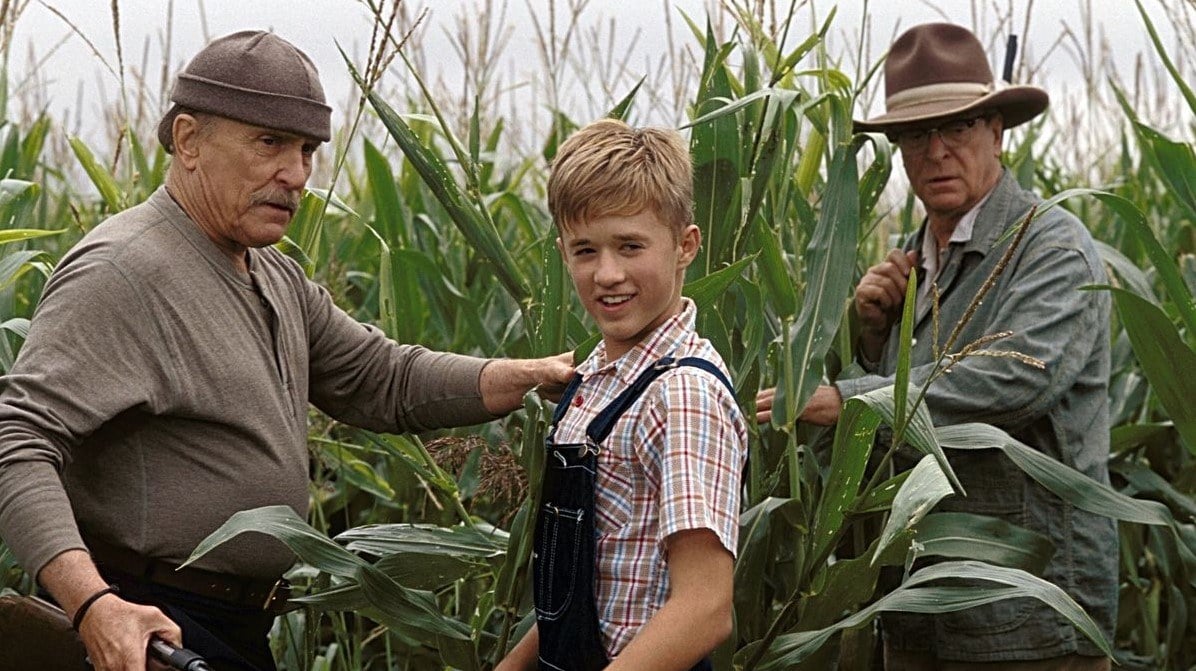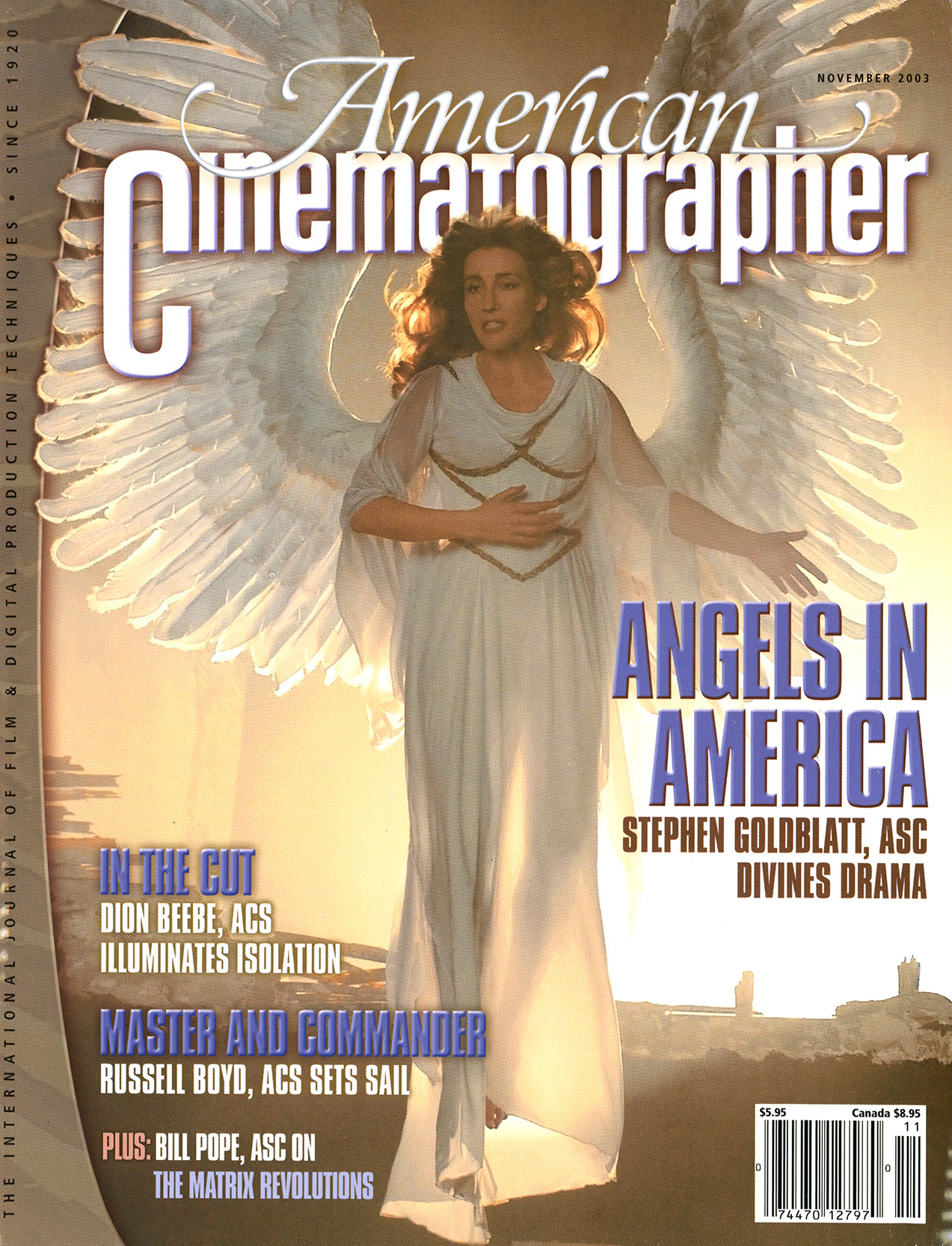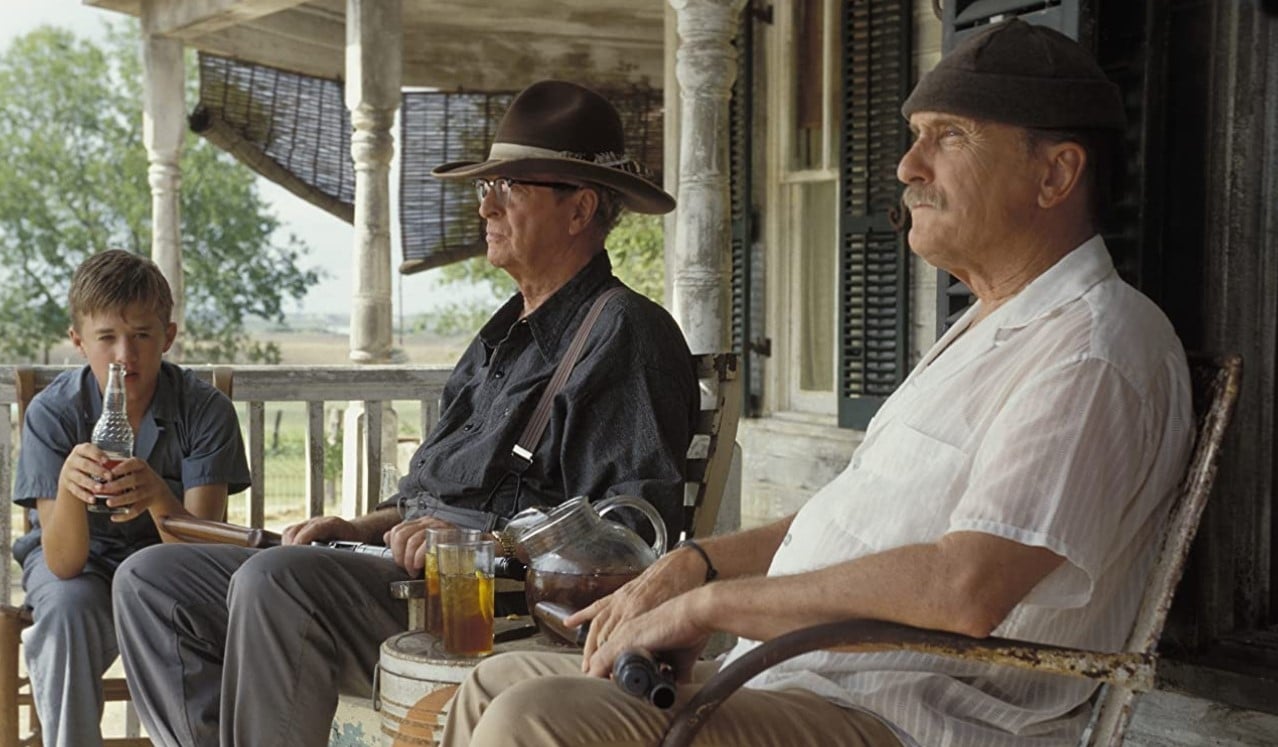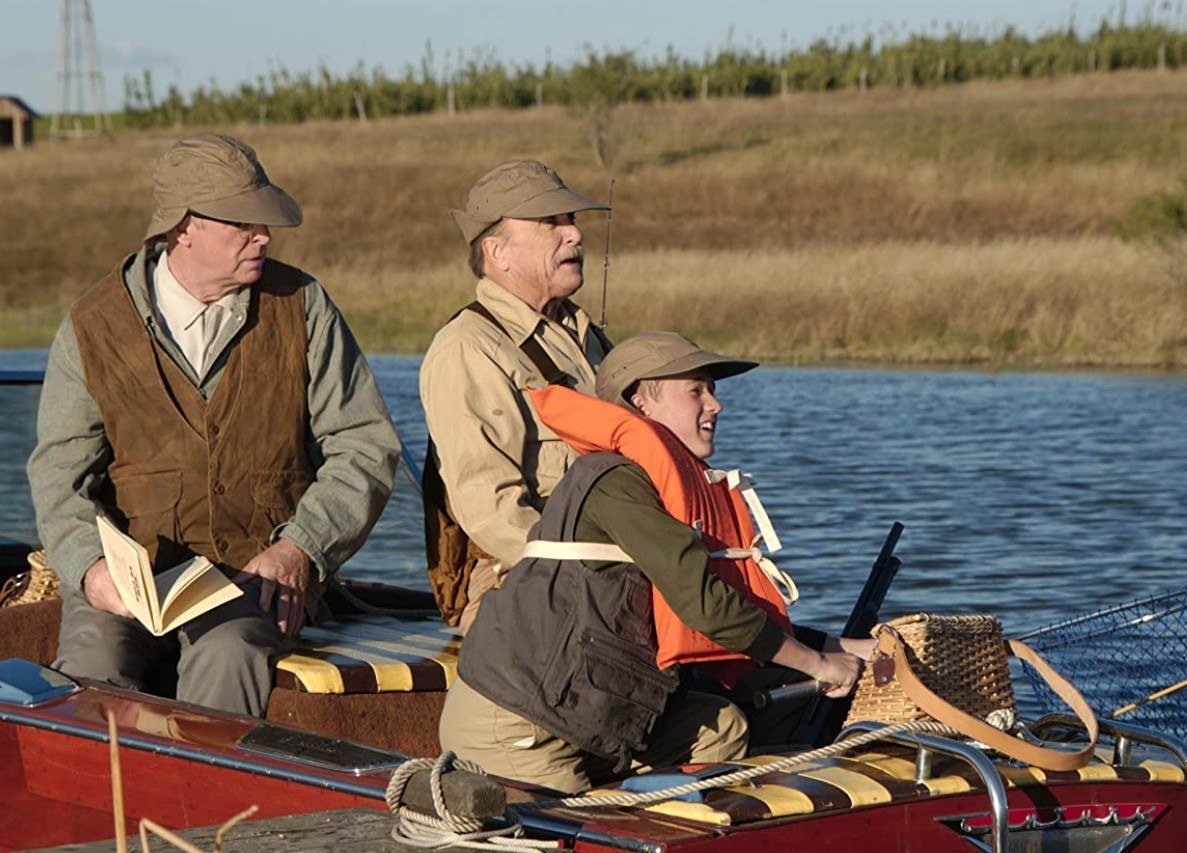
Secondhand Lions: Tall Tales
Shot by Jack N. Green, ASC, this come-of-age yarn puts a pair of colorful characters in the spotlight.

Unit photography by Van Redin
In the dusty rural landscape of 1960s Texas, young Walter (Haley Joel Osment) is deposited on the front porch of his estranged uncles’ farm for the summer by his scheming, gold-digging mother (Kyra Sedgwick), who says she’s going to enroll in school to make a better life for her son. But as uncles Hub (Robert Duvall) and Garth (Michael Caine) know, and Walter comes to realize in time, his mother’s plan is nowhere near as noble as she claims. For mysterious reasons, the uncles have a seemingly endless supply of cash that all of their relatives, including Walter’s mother, are trying to exploit.

Secondhand Lions tells of Walter’s summer on the farm. The boy’s presence annoys all of his money-hungry relatives, which gives Hub and Garth good cause to keep the young lad in their charge. After a time, Walter convinces his uncles to begin spending some of their money. One of their outrageous purchases is a “secondhand” circus lion that they plan to hunt on their farm; the lion, however, isn’t having any of it, and she merely loafs in her traveling crate. Walter sees potential in the timid cat and vows to take care of her until she can live up to his uncles’ plan.

Secondhand Lions was written and directed by Tim McCanlies and photographed by Academy Award nominee Jack Green, ASC (Unforgiven, The Bridges of Madison County). According to the cinematographer, the film’s extensive day exterior work often put the production at odds with stubborn Mother Nature. “Young cinematographers often think day exteriors are a piece of cake, but when they find themselves actually shooting them, they discover how incredibly difficult they really are,” says Green. “Day exteriors are the hardest part of a cameraman’s challenge to make pictures that work and look decent. You can light forever and make really interesting and pretty pictures, but boy, day exteriors jump up and bite you every time!” The cinematographer reports that about 70 percent of Secondhand Lions is day exteriors, and during the shoot, “we were absolutely tortured with the crudest weather I’ve ever had to confront. It was truly a monster. On a 55-day schedule, we had built-in 11 days of cover for inclement weather, but we used up those days in the first two weeks! Timing is everything in any endeavor, and you’re either in step or out of step. On this film, we never got into a weather step — and I mean never. There wasn’t one scene that we started and finished in the same weather. Because of the heavy rain, we had to abandon some locations because we were afraid we wouldn’t be able to get the trucks out of them.”

When the sun cooperates, Green prefers to keep his subjects in backlight as much as possible. “On this picture, my key grip, Ferrell Shinnick, introduced me to Hilite material [Rosco Cinegel #3014], and I fell in love with it. We used that to diffuse sunlight, or put it up and pumped 12K and 18K HMIs through it to create our own sunlight. We were scrambling for fixtures on this show, and my gaffer, Colin Campbell, worked miracles to find just about every big HMI in Texas. The Hilite gives the sense that sunlight is real, but the shadows aren’t severe. It gives you the best of both worlds, in that it allows you to proceed swiftly and also makes the actors look good.
“On every project, there is always a struggle between the factors of budget and the factors of artistry,” he continues. “On some pictures, the budget is flexible because all the powers-that-be care about is getting the best images, whereas on others, the budget might be so tight that you don’t have time to achieve the best images, so you just do the best you can. Most projects fall somewhere in between, and the reality is that you have a great deal of leeway in terms of picture continuity if the story has beautiful narrative continuity. It’s the cinematographer’s job to make that cloudy day look just like the last moment that was shot under a sunny sky, but if the audience is along for the ride, we can get away with fudging quite a bit.”

Because of all the inclement weather, the Secondhand Lions team had to find a way to stay on schedule. The McCaan farm interior, created by production designer David Bomba and his crew, was built on stage in Austin, Texas. The filmmakers quickly decided that many of the scenes showing Walter and his uncles sitting on the porch would have to be shot on stage as well. “The set was built for the interiors of the farmhouse, and it was wonderfully planned out so that every angle was covered with great backgrounds or TransLites,” Green recalls. “But when we started to fall behind because of the weather, we realized we would have to create an exterior portion of the set as well. As it turned out, the [porch] set worked perfectly, and we photographed the heck out of it. We certainly couldn’t have stayed on schedule without it.”
For the porch scenes, Green used a pair of 12K HMIs through Hilite diffusion to match the natural daylight look that he had filmed on location. “I didn’t have to add much ambient light because the Hilite spreads the light so evenly and realistically,” he explains. “It was really very simple to get the same natural look on stage.” To help maintain consistency, Green continued using his day-exterior stock, Kodak Vision 200T 5274, for the shots on stage that had to match. (He used Kodak Vision 500T 5279 for all night sequences.) Green attests that he always overexposes Kodak stocks by ⅓ of a stop and then works in the “mortgage factors,” which is an additional bump open on T-stops to ensure a strong negative. “I generally like to print in the high 30s and low 40s,” he adds.

overexposed his
Kodak stocks by
1/3 of a stop and
worked in the
"mortgage
factors," an
additional bump
open on T-stops
to ensure a
strong negative.
As Secondhand Lions progresses, Walter and his uncles become more comfortable with each other. To suggest this visually, Green began adding slight warmth to the image. “The movie is actually set up as an older Walter reflecting on his youth,” he explains. “Because those memories are so wonderful to him, I felt they should have a warm feel; when you warm up the image, it seems to warm the audience as well. I used [Tiffen] Gold Diffusion/FX on many of those sequences to give them a golden warmth. I don’t like to use a lot of diffusions; as a cameraman, I feel it’s much better to check your ego at the door and let the audience come away with their own impressions of a scene, rather than spelling it out for them. At times, however, I’ll use slight diffusion for a subtle effect. I really loved what the Gold Diffusion/FX was giving me on this picture — I actually used it more for its color qualities than for its diffusion capability. I usually used the FX Half, the weakest strength available.”
When Walter spends his first night in the McCaan house, the brothers give him a room in a tower jutting from the farmhouse roof. The tower doesn’t have electricity, so Walter is given a kerosene lamp to find his way to bed. “To match the look of the kerosene lamp, we put a 250-watt standard bulb in a China ball and dimmed it way down until we got that warm color, and then we added a moonlight kick through the windows with a little half CTB,” says Green. “That was all we did. I’ve come to learn that the simpler you keep it, the better off you are. Every time I find myself working too hard to complicate something, I try to back off and look for the simplest approach.”

It is in the dusty confines of his new attic home that Walter discovers a picture of Hub’s long-lost love, jasmine (Emmanuelle Vaugier). He questions Garth about the woman and is treated to epic stories of the brothers’ adventures in the Foreign Legion. These tales come to life in Walter’s imagination and onscreen in warm, glowing visual vivacity. Green used Tiffen specialty filters to give these sequences a hint of romanticism. “I used the Color Enhancer to accentuate the warm tones in the fantasy sequences where Walter imagines the stories his uncles are telling him,” says the cinematographer. “It’s amazing how vibrantly it picks up the reds in the image and just saturates them. We also plan to use the digital intermediate to further accentuate the magical glow.
“The Enhancer is a very neat tool, but it can be dangerous, too,” Green cautions. “It can cause your printer lights to run a bit wild, especially in blue and red, and it can also cause flesh tones to pink up very quickly. We’ve had to watch that in timing those sequences.”
For the fantasy sequences, Green also added a ½ Tiffen Black FX filter to match the look of sequences shot with the Gold Diffusion/FX. “While I didn’t want a whole lot of diffusion on the picture, I wanted a continuity to the image, especially the memories Walter is most fond of. I felt that if I didn’t add some diffusion to the fantasy sequences, they would play a bit too sharp and different from the other scenes, and I didn’t want the audience to be aware of being manipulated by diffusion if the sequences were too different. Also, I didn’t want to add the Gold Diffusion/FX on top of the Color Enhancer, as I felt that was pushing the gold hues too far.”

One of the stories Garth shares with Walter details a trip to an Arabian bazaar, where Hub and Jasmine confront guards who have been sent to return Jasmine to an evil sheik. The bazaar sequence was filmed on a river walk in Austin that had been shut down because of recurrent flooding. In keeping with the filmmakers’ luck, storm clouds were looming when they arrived at the location. “We brought in every big HMI we had and stacked them all up on one side through the Hilite diffusion to create a sense of that Arabian sunlight,” recalls Green. “It was a lot more work than we were planning on, but the set really turned out beautifully.
“All in all, the cinematographer’s work is about balance,” he concludes. “You’ve got to find a balance between the elements of production — its financial and schedule aspects — and making pretty pictures. Keeping things as simple as possible really helps, especially on a picture like Secondhand Lions. The story is so sweet and warm that it doesn’t call for a lot of visual trickery. It’s all about the story and the audience having the best experience possible with that story.”
Anamorphic 2.40:1
Panavision cameras/C- and E-Series lenses
Kodak Vision 200T 5274 and Vision 500T5279
Digital Intermediate (select scenes) by Technique
Printed on Fuji
Green was honored with the ASC Lifetime Achievement Award in 2009.






